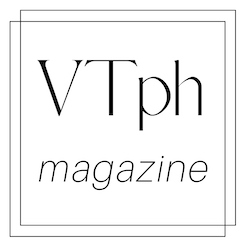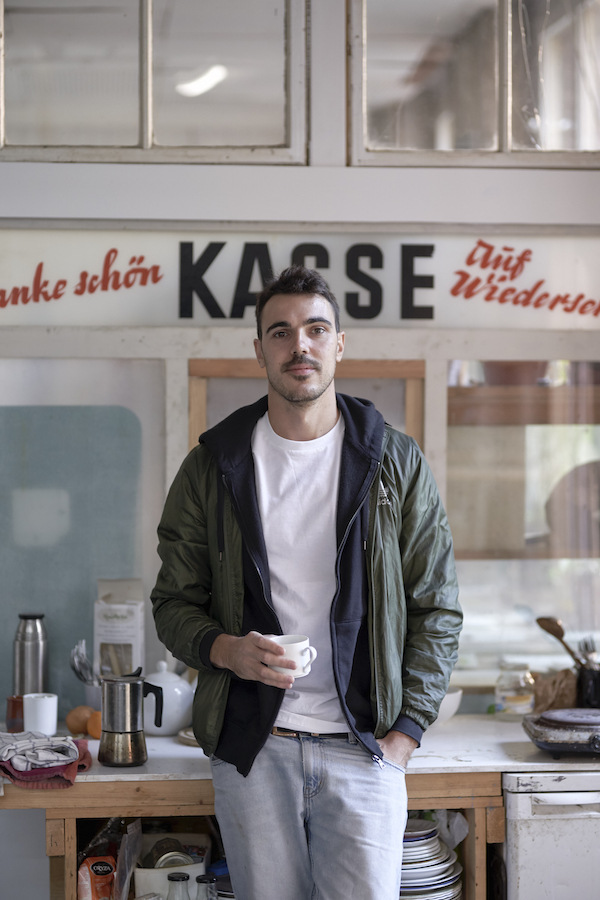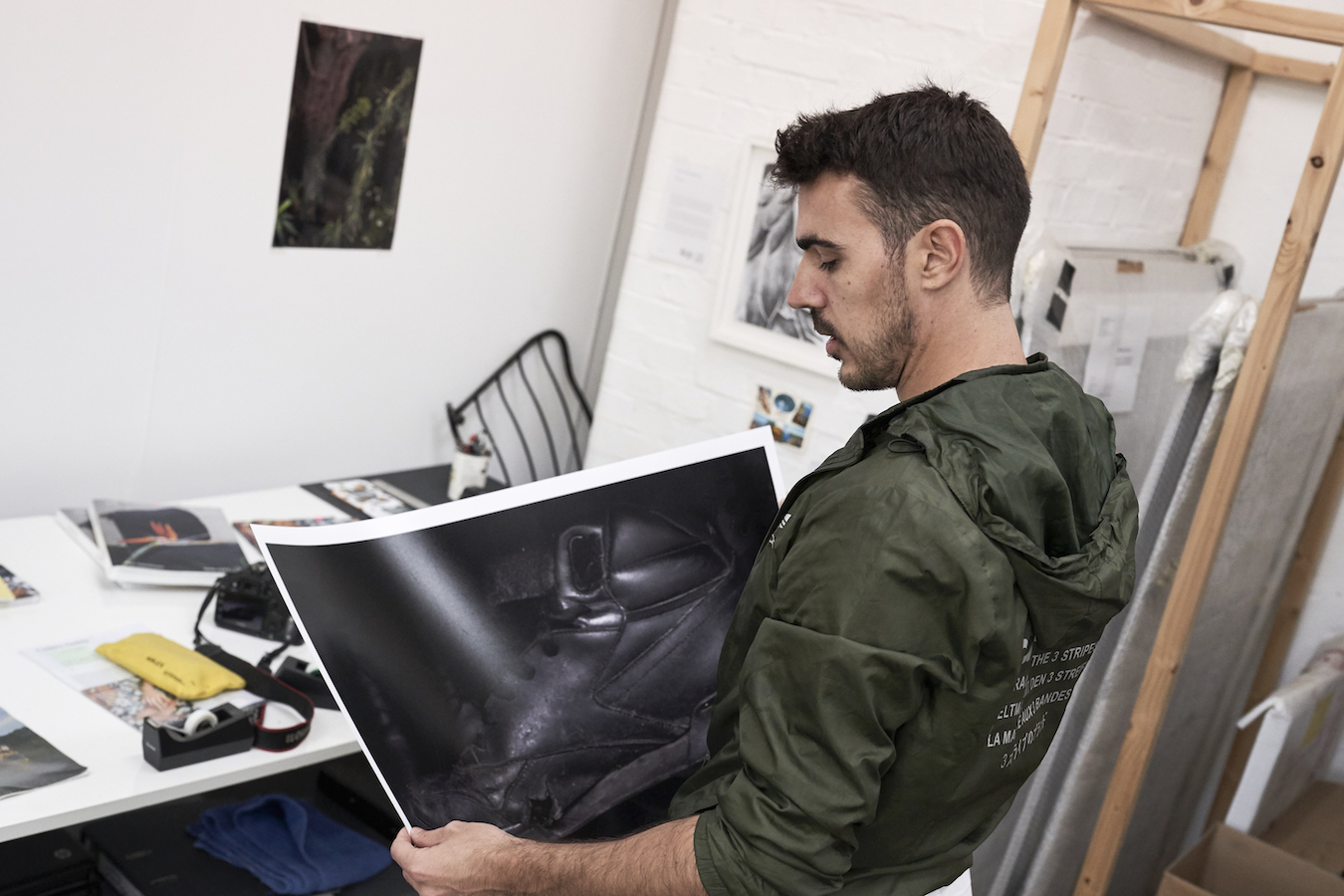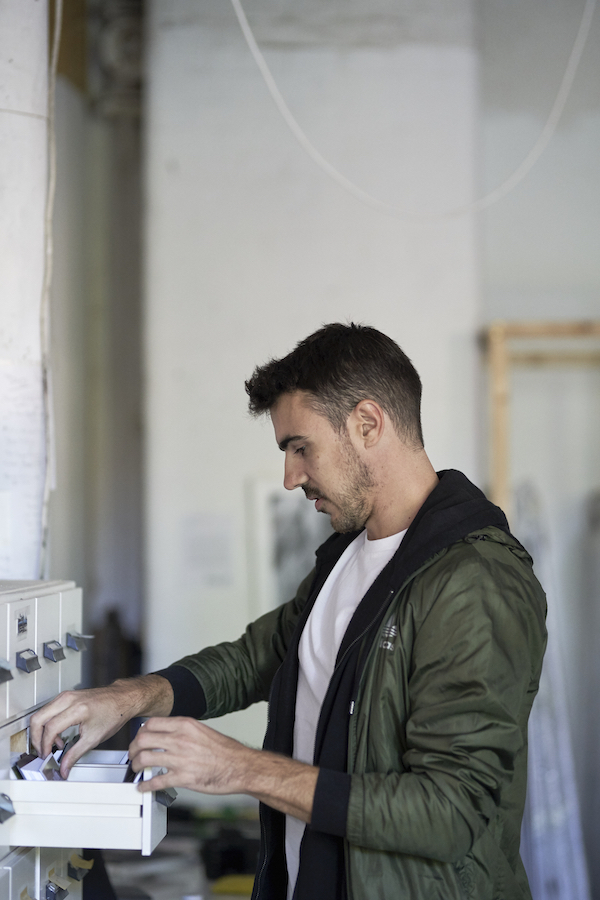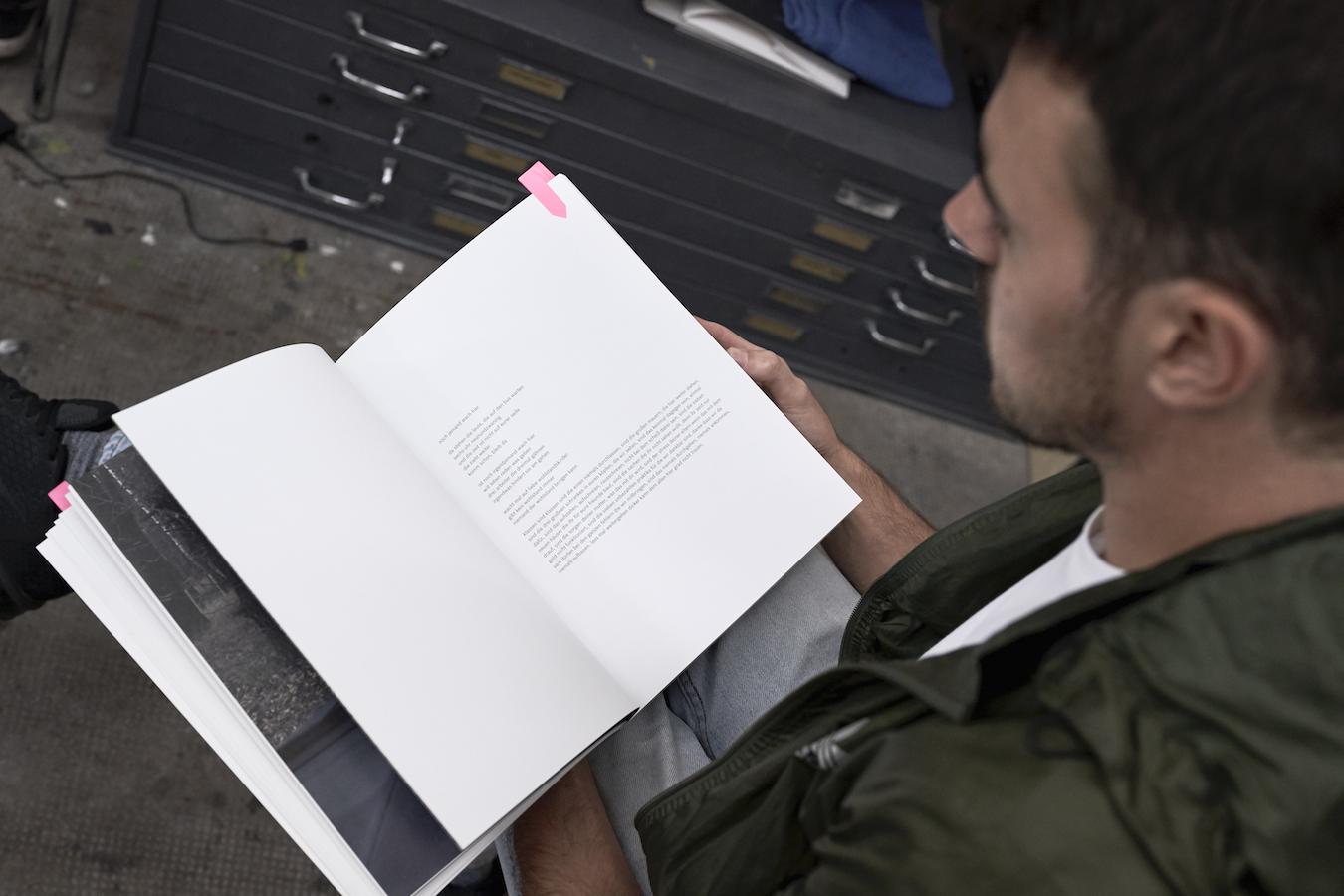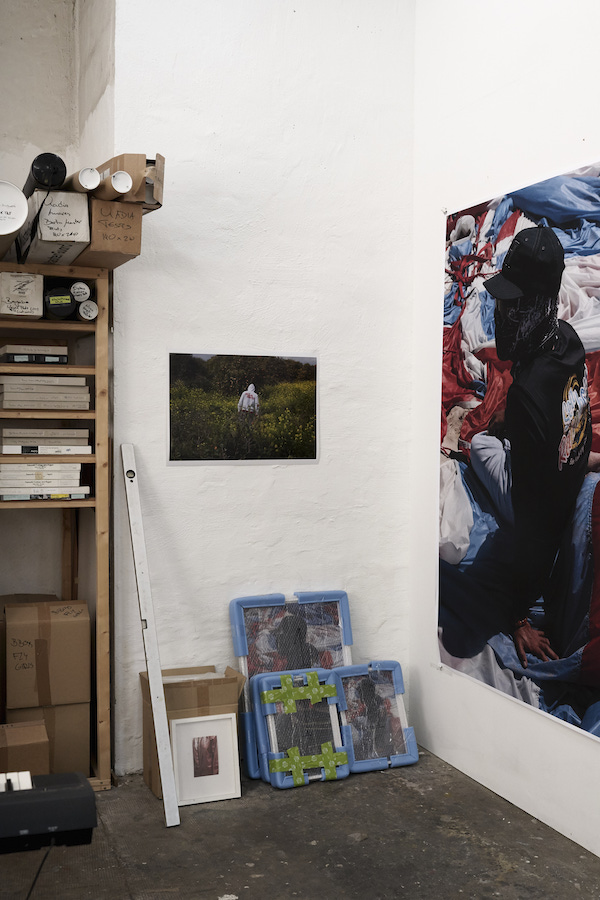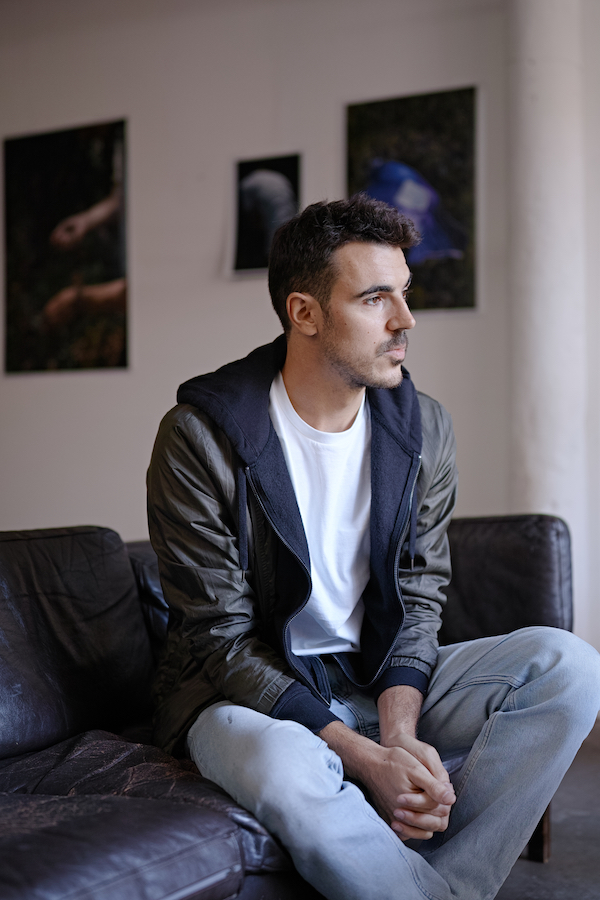Paul Hutchinson / Studio Visit
Paul Hutchinson (*1987) grew up in a German/Irish family in Berlin, he studied there at Universität der Künste and at Central Saint Martins College of Art and Design, University of London. A conversation about origins, visual and textual language as well as his latest works.
Julia Rosenbaum / StudioVisits: As a teenager you were part of the Berlin Hip-Hop scene of the 1990s.
Paul Hutchinson: People are always quick to say, ‘part of the hip-hop scene’, also because I used that phrase myself a few years ago. But I have come to realise that this has led to the wrong associations. Hip-Hop scene doesn’t convey the right image. It makes you think of gigs, active participation, music production and a small, narrow circle. That was also part of it. But for us the music-making aspect was rather passive. Hip-hop was something unconscious that we took for granted, like a background noise – and many of us didn’t contribute actively to it. The whole culture that I grew up in and that influenced me contains a million other things that are not exclusively related to hip-hop. That would be too insular. Other important keywords are immigration, language, street culture. For instance, we didn’t have any breakdance. And graffiti also remained on the margins. Alpha male posturing, even aggression, mugging and selling/buying weed were very present. That’s North-Schöneberg of the 90s/2000s. Schöneberg 30. Hip-hop was of course part of everything, but it never really felt special, or like a ‘scene’. It just felt like an ordinary youth in the city. I mean the Royal Bunker was founded on Yorkstraβe, people like KKS/MOR, Aggro Berlin, were important in that area back then. But so were many other things.
What brought you from there to photography?
Looking at it retrospectively, what brought me to photography is that I wanted to get away from the then grey, musty and rough West-Berlin. I wanted to see more than just Kleistpark and all those places and faces. Therefore education and travel. Living elsewhere, exploring other circles. I was always aware of the disposition of having a German passport and thus being eligible for German funding opportunities. And to be naturally curious. And I have always felt very privileged in that way. To just feel like doing stuff and generally to be in a good mood – especially after I spent a lot of my time as a teenager smoking weed and hanging out or making trouble – was something I was always grateful for and still am today. And the translation of these experiences, of my travels, but also the notion of somehow having been fortunate enough to find myself undergoing an academic education and amongst very educated people, the physical manifestation of all that, for me personally, was to take pictures.
How have your childhood and youth influenced your photography?
I believe that everything I do, all my activities, are somehow linked to where I come from and the experiences, I have been able to make since.
Your style can neither be referred to as documentary nor does it belong to purely poetic-artistic aesthetics.
When looking at my work, it’s useful to bear in mind that I am purposefully creating my own system of references to reflect my inner emotions and my perception of our reality. Within this system metro stations can exist next to butterflies and next to trainers because they all have a similar air to them and they reflect the mindset with which I approach the world: naivety.
Revealing this and to be open about it, as well as the experiences that come with it – on the one hand a profound belief in all that’s good and positive in life, on the other failure and the aggression and despair that come with it –, is what defines my voice. Just life, really.
I also think that ‘style’ is a problematic term to apply to art and I would say that’s not what it’s all about. The question of style arises in the second and third instance. And I think one shouldn’t focus on trying to emulate it. First of all, it’s about content and, maybe, emotion. At least that’s how I perceive art.
In 2016 you were awarded the Eberhard-Roters-Stipendium (bursary) for Young Art, which apart from an acquisition by the Berlinische Galerie, Museum of Modern Art, also comes with a grant of 15,500 Euros.
Yes, that was somehow an important moment when I thought: ‘Okay, maybe I can actually do this.’ To put aside any daydreaming and really, pragmatically, think about the future and realise – this could be my job one day, no joke. Someone’s actually paying me to do this. Without this kind of support and the recognition of the work that comes with it, the incentive to carry on, I wouldn’t have been strong enough to develop my own practice. There are of course many ways in which things could be improved, but generally I believe we should consider ourselves extremely lucky that we have this cultural infrastructure here in Germany. And what it makes possible for society as a whole, not just with regard to artists. The achievements of the KSK or the BBK alone should always be mentioned I think – these institutions are not something we should take for granted.
For the series ‘Schmetterlinge’ (Butterflies) you are looking at an almost classical subject. That’s brave, since animal pictures are usually something for National Geographic.
Yes, totally. At first, I was also wondering what this is all about. But after a while it all made sense and I began to see in these comical motifs, partly my own collages, a kind of bittersweetness and poetry, which corresponds to my work in general. I always think that we should allow ourselves to take risks and not be afraid of failure. Initially, I wasn’t sure about the butterflies – something that now feels completely natural and carries so much narrative – and I was almost too embarrassed to really go ahead with it. A few years later you then realise ‘Oh no, that was exactly right’. And as you gain experience with creating work you learn to trust precisely this inner intuition and how to channel it. I always think that the courage to be free in artistic production as we know it from Polke, Richter or Kippenberger or a Hannah Höch is maybe what art is missing nowadays. When everything is so corporate and slick and clear profiled. I always found the spectrum of variation that those positions contained to be very inspiring.
„It was important for me, or there was never really another way to do so, to articulate the aesthetics and the relevance that I see in rather rough subjects – linguistically as well as semantically. I engage quite a bit with literature, and I have realised for instance that I haven’t yet been able to find the form in which I communicate on a daily basis, represented in contemporary German literature. I never understood that. Why do the books of today speak so differently to the way I speak? Where are my people in these books? Where is my language?“–Paul Hutchinson
Your publication ‘Pictures and Words’ (Texte und Bilder) also deals with a subculture, this time the pictures were mostly taken in Berlin. Are we encountering the portrait of a generation or rather a way of life?
No, I don’t think that I would be in a position to portray my generation – that’s not what I’m trying to do. For instance, I don’t feel like I am in any way part of the whole ‘New Creative Berlin’ international start-up thing which is taking up more and more space amongst members of my generation. Or the hip and cool and Berghain way of being. This is simply my home here, my heimat. The place I breathe and feel and live. And if I take pictures of people it’s because I feel some kind of affection for them, or because I admire them. Not because they are seemingly appropriate representatives of their generation. I can only talk about my own world and my own experiences and I have no ambition to do anything else. If there is a particular way of being in my work, then it’s the one that I carry within myself.
At first glance your books always seem like a spontaneous snapshot, on closer inspection they turn out to be delicate photographic compositions. I imagine that this tension is a difficult balancing act. What does your work process up to completion look like?
I work very intuitively. If something moves me, positively or negatively, then I try to translate it into images or words. The result is a lot of material and it’s my job afterwards to adequately and precisely filter this material. So that what I want to say or feel, becomes visible. After all, it’s part of my job now, to share this. And ideally this moves someone somewhere and therefore maybe creates some sort of value or makes someone feel understood. But yes, generally this is my process: overproduction and then filtering it down.
In addition to your photography you also write texts. What do they mean to you?
The texts have their own life, next to my images. They are not an illustration of my photographic practice, instead they exist equally and independently. Writing has been a part of what I do for quite some time now. And after a while I realised that the texts don’t close my work down, but rather open them up. So I thought it might be justifiable to publish them. The texts act with a similar urge as the images, I think. It was important for me, or there was never really another way to do so, to articulate the aesthetics and the relevance that I see in rather rough subjects – linguistically as well as semantically. I engage quite a bit with literature, and I have realised for instance that I haven’t yet been able to find the form in which I communicate on a daily basis, represented in contemporary German literature. I never understood that. Why do the books of today speak so differently to the way I speak? Where are my people in these books? Where is my language? The decision to forge ahead and publish these seemingly embarrassing non-academic street texts was the result of all of that. And now this also feels honest and right to me.
In your catalogue and photography book ‘Pictures and Words’ (Texte und Bilder) published by Distanz Verlag, you combine pictures and texts for the first time. What’s happening there?
I believe that these images and texts are good for each other. And I think they challenge the way people engage with pictures in general and with my work in particular.
There are two editions of the catalogue: one published in English and another one in German. Have you had all texts translated or was it simply not possible to translate some of them because they would suddenly have sounded so differently in the other language? How did you deal with the differences between the two languages?
I write in German and I write in English, I was raised bilingual. With some texts I managed to do a free translation, with others it just wasn’t possible. In both editions of the book there are a few translations, maybe 30% of all texts (translated from English to German as well as from German to English). I did all the translations myself, anything else wouldn’t feel right. The rest are simply different texts. So really these are two different books. Personally, I almost find it easier to write in English, the risk of sounding pathetic is much smaller than in German. German is more difficult to me but also much more rewarding if you manage to pull it off, to be precise. At the same time, it’s much more disastrous if you fail, which is easier to hide in English again. Even though they both convey a similar way of life, I would say that the English edition is a bit more optimistic, a bit warmer. The German edition is a bit rougher but in parts also more independent. Despite the bilingualism, I still went to school in Berlin and that’s also where I feel the socialisation of my early years much more strongly than, for instance, in Ireland. That’s of course reflected in my language.
Do politics play a role in your work?
The more I produce the more I realise myself that almost anything I engage with is, if seen from a distance, politically motivated. Engaging with social inequality, the hierarchies of
language, the motif of uprisings against so-called authorities. That is the prevailing mood of my work, which carries everything and holds it together.
Do you feel a responsibility as an artist to make your voice heard politically?
No, not necessarily as an artist, but as a human being. In my own case there is a certain motivation behind my works, but art can also work perfectly free of politics. However, as a conscious and feeling human being I think about the world we live in – just like all other conscious and feeling human beings too – and I articulate whatever occupies my mind, be it positive or negative.
Interview: Julia Rosenbaum, October 2019
Translation: Katharina Volckmer
Paul Hutchinson (*1987) wuchs als Deutsch-Ire in Berlin auf und studierte dort an der Universität der Künste sowie an der Central Saint Martins University of the Arts in London. Ein Gespräch über Herkunft, Bild und Textsprache sowie die neueste Arbeit.
Julia Rosenbaum / StudioVisits: Du warst als Jugendlicher Teil der Berliner Hip-Hop-Szene der 1990er Jahre.
Paul Hutchinson: Das mit „Teil der Hip-Hop“ Szene wird immer schnell gesagt, auch weil ich das selbst mal vor Jahren so formuliert hatte. Mir ist inzwischen aufgefallen, dass damit die falschen Assoziationen geweckt werden. Hip-Hop Szene vermittelt das falsche Bild. Da denkt man schnell an Konzerte, aktives Teilhaben und Musikproduktion und an einen kleinen, engen Kreis. Das gab es auch. Aber bei uns war es vom Musikmachen her eher passiv. Hip-Hop war unbewusst und selbstverständlich wie ein Hintergrundrauschen – für das viele von uns nichts aktiv produziert haben. Zu der gesamten Kultur, mit der ich aufgewachsen bin und die mich geprägt hat, gehören tausend andere Sachen, die nicht ausschließlich mit Hip-Hop zu tun haben. Das wäre zu klein. Wichtige Schlüsselworte sind auch Immigration, Sprache, Straßenkultur. Bei uns gab es z.B. kein Breakdance, auch Graffiti gab es nur peripher. Präsent war Alphagehabe, auch Aggression, Abziehen, Ticken. Das ist Nord-Schöneberg der 90er/2000er Jahre, Schöneberg 30. Hip-Hop schwebte dabei natürlich über allem, aber fühlte sich nie wirklich besonders oder „szenig“ an, sondern einfach wie eine Standard-Jugend in der Stadt. Klar, der Royal Bunker wurde in der Yorckstraße gegründet, Leute wie KKS/MOR, Aggro Berlin, waren damals in der Gegend wichtig. Aber vieles andere auch.
Wie kamst Du von da zur Fotografie?
Zur Fotografie kam ich, retrospektiv betrachtet, weil ich aus dem damals grauen, muffigen, rauen West-Berlin weg wollte. Und mehr sehen wollte als nur den Kleistpark und die ganzen Orte und Gesichter. Deswegen Bildung und Reisen. Woanders leben, andere Kreise kennenlernen. Über die Disposition, einen deutschen Pass zu haben, damit für deutsche Fördermöglichkeiten berechtigt zu sein und diese innere Neugierde zu haben, war ich mir immer bewusst und habe mich damit privilegiert gefühlt. Einfach Lust zu haben, Sachen zu machen und allgemein gut drauf zu sein – vor allem nachdem ich viel Zeit in meiner Jugend mit Grasrauchen und Rumhängen oder mit Stressmachen verbracht hatte – war etwas, worüber ich dankbar war und noch heute bin. Und die Übersetzung von diesen Erfahrungen, von dem Reisen, aber auch von dem Gefühl irgendwie aus Glück in einer akademischen Ausbildung und unter viel gebildeteren Menschen gelandet zu sein, der physische Umgang damit, folgte dann bei mir persönlich über das Bildermachen.
Was für einen Einfluss hatte Deine Kindheit und Jugend auf Deine fotografische Arbeit?
Ich glaube, alles was ich tue, all meine Aktivitäten, sind in irgendeiner Form darauf zurückzuführen, wo ich herkomme und welche Erfahrungen ich seitdem machen konnte.
Dein Stil ist weder in der dokumentarischen noch in der rein poetisch-künstlerischen Ästhetik einzuordnen.
Bei der Betrachtung meiner Arbeit ist es sinnvoll, sich zu vergegenwärtigen, dass ich bewusst ein eigenständiges Referenzsystem aufbaue, was meine innere Gefühlswelt und meine Wahrnehmung unserer Realität reflektiert. Innerhalb dessen können U-Bahnhöfe neben Schmetterlingen neben Turnschuhen existieren, weil sie alle einen ähnlichen Gestus in sich tragen und das widerspiegeln, mit dem ich der Welt begegne: Naivität.
Das Offenlegen davon und der ehrliche Umgang damit, sowie die damit verbundenen Erfahrungen – auf der einen Seite ein tiefer Glaube an das Gute und Positive im Leben, auf der anderen auch das Scheitern und die damit verbundene Aggression oder Verzweiflung – definieren meine Stimme. Das Leben halt. Ich finde „Stil“ auch einen schwierigen Begriff innerhalb der Kunst und würde sagen, darum geht es eigentlich nicht. Stil ergibt sich an zweiter oder dritter Stelle. Und sollte nicht vordergründig das sein, dem man nacheifert. Es geht ja erst einmal um Inhalt und, vielleicht, Emotion. In meiner Wahrnehmung von Kunst zumindest.
2016 wurdest Du mit dem Eberhard-Roters-Stipendium für Junge Kunst geehrt, das neben einem Ankauf von der Berlinischen Galerie auch mit 15.500 Euro dotiert ist.
Ja, das war irgendwie ein wichtiger Moment, in dem ich gedacht habe: „Okay, ich kann das hier vielleicht wirklich machen“. Also das Hintenanstellen von Träumereien und wirklich, lebenspragmatisch, das Bewusstsein langsam aufzubauen – das könnte hier echt mal mein Job sein, no joke. Die geben mir grade Geld hierfür. Ohne derart Förderungen und die damit verbundene Anerkennung der Arbeit, das Gefühl von Weitermachen, wäre ich nicht stark genug gewesen, meine Praxis zu entwickeln. Natürlich gibt es unzählige Möglichkeiten der Verbesserung, aber allgemein müssen wir uns extrem glücklich schätzen, dass es hier in Deutschland diese kulturelle Infrastruktur gibt und was sie, nicht nur in Bezug auf Künstler, sondern gesamtgesellschaftlich, ermöglicht. Allein die Leistungen der KSK oder des BBK etc. sind immer wieder hervorzuheben, finde ich – und sie sind nicht selbstverständlich.
In der Serie „Schmetterlinge“ betrachtest Du ein fast klassisches Sujet. Mutig, denn Tierbilder sind ja eher etwas für National Geographic.
Ja, total. Ich hab mich auch erst einmal gewundert, was das soll. Aber mit der Zeit hat es Sinn ergeben und ich konnte in diesen komischen, von mir teilweise real-collagierten, Motiven eine Art bittersweetness und Poesie sehen, die meiner Arbeit im Allgemeinen entspricht. Ich denke immer, man sollte sich etwas Fallhöhe zutrauen und auch mal Mut zum Scheitern zeigen. Anfänglich war mir das mit den Schmetterlingen nicht geheuer – etwas, das sich jetzt so natürlich anfühlt und soviel eigene Narration trägt – und es war mir fast peinlich, das wirklich durchzuziehen. Ein paar Jahre später merkt man dann „Ach nee, war genau richtig“ und mit der Übung im Produzieren lernt man dann, genau auf diese innere Intuition zu vertrauen und sie zu kanalisieren. Ich denke immer, der Mut zur Freiheit in der künstlerischen Produktion von einem Polke, Richter oder Kippenberger oder einer Hannah Höch ist vielleicht das, was der Kunst heute fehlt. Wenn alles so corporate und slick und klar profiliert wird, ist es doch langweilig. Die Variationsbreite, die solche Positionen hatten, fand ich immer inspirierend.
„Mir war es wichtig, oder es ging auch nie wirklich anders, diese Ästhetik und die Relevanz, die ich in eher roughen Sachen sehe, zu formulieren – sprachlich wie auch semantisch. Ich beschäftige mich auch relativ stark mit Literatur und mir ist z. B. aufgefallen, dass ich schlichtweg die Form, in der ich tagtäglich kommuniziere, bisher nicht in der deutschsprachigen, zeitgenössischen Literatur wiedergefunden habe. Das hatte ich nie verstanden. Warum sprechen die in Büchern von heute anders als ich heute spreche. Wo sind meine Leute in diesen Büchern? Wo meine Sprache?“–Paul Hutchinson
In deiner Publikation „Texte und Bilder“ geht es auch um eine Subkultur, diesmal sind die Bilder größtenteils in Berlin entstanden. Begegnen wir einem Porträt einer Generation oder eher einem Lebensgefühl?
Nein, ich denke, ich wäre nie in der Lage, meine Generation zu porträtieren – dazu habe ich keine Ambition. Ich fühle mich z.B. in keiner Weise Teil von dem „New Creative Berlin“ oder der internationalen Startup-Szene, die immer mehr Raum bei Vertretern meiner Generation einnimmt. Oder von dem Hip-und-Cool-und-Berghain-Sein. Das ist hier halt mein Zuhause, meine Heimat. Und wenn ich Leute fotografiere, dann weil ich in irgendeiner Form eine Zuneigung zu Ihnen verspüre oder sie bewundere. Nicht, weil sie vermeintlich adäquat ihre Generation repräsentieren. Ich kann nur über meine eigene Welt und meinen Erfahrungshorizont sprechen und habe auch keine weiteren Ambitionen, als das zu tun. Wenn es ein Lebensgefühl in meiner Arbeit gibt, dann das, was ich in mir drin trage.
Auf den ersten Blick erscheinen Deine Bücher wie eine spontane Momentaufnahmen, nach genauem Hinsehen enthüllen sie sich als feine fotografische Komposition. Diese Spannung stelle ich mir wie ein schwieriger Balanceakt vor. Wie sieht Dein Arbeitsprozess bis zu der Fertigstellung aus?
Ich arbeite sehr intuitiv. Wenn mich etwas bewegt, positiv oder negativ, dann probiere ich, das in Bilder oder in Worte zu übersetzen. Dabei entsteht relativ viel Material und meine Aufgabe ist es, dieses Material adäquat und präzise zu filtern. Sodass das, was ich sagen möchte oder empfinde, zum Vorschein tritt. Das ist halt jetzt meine Arbeit, das zu teilen. Und im besten Fall berührt das irgendwo jemanden und schafft dadurch vielleicht einen Mehrwert oder eine Verbindung. Aber ja, allgemein ist mein Prozess: Überproduktion und dann runter filtern.
Parallel zu Deinen Fotografien schreibst Du auch Texte. Was für eine Bedeutung haben sie für Dich?
Die Texte stehen autark neben den Bildern. Sie sind keine Illustration meiner fotografischen Praxis, sondern existieren gleichwertig und unabhängig. Das Schreiben ist seit längerem Teil von dem, was ich tue. Und mir ist nach einiger Zeit aufgefallen, dass die Texte die Arbeit nicht zumachen, sondern öffnen. Dann dachte ich, es wäre vielleicht auch vertretbar, sie zu publizieren. Die Texte agieren mit einem ähnlichen Drängen wie die Bilder, finde ich. Mir war es wichtig, oder es ging auch nie wirklich anders, diese Ästhetik und die Relevanz, die ich in eher roughen Sachen sehe, zu formulieren – sprachlich wie auch semantisch. Ich beschäftige mich auch relativ stark mit Literatur und mir ist z. B. aufgefallen, dass ich schlichtweg die Form, in der ich tagtäglich kommuniziere, bisher nicht in der deutschsprachigen, zeitgenössischen Literatur wiedergefunden habe. Das hatte ich nie verstanden. Warum sprechen die in Büchern von heute anders als ich heute spreche. Wo sind meine Leute in diesen Büchern? Wo meine Sprache? Die Flucht nach vorne und das Publizieren von diesen vermeintlich peinlichen, nicht-akademischen Straßentexten war dann das Ergebnis davon. Und mittlerweile fühlt sich auch das für mich ehrlich und richtig an.
In Deinem im DISTANZ Verlag veröffentlichten Katalog und Fotoband „Pictures and Words“, bzw. „Texte und Bilder“ bringst Du Bild und Text erstmals zusammen. Was passiert da?
Ich glaube, die Bilder und Texte tun einander gut. Und ich glaube, sie fordern nochmal die Weise heraus, mit der sich die Menschen mit Bildern im allgemeinen, und meiner Arbeit im spezifischen, beschäftigen.
Es gibt zwei Ausgaben des Katalogs: Eine erscheint auf Englisch und eine auf Deutsch. Hast Du alle Texte übersetzen lassen oder konnten einige Texte einfach nicht übersetzt werden, da sie plötzlich einen anderen Klang in der jeweils anderen Sprache einnahmen? Wie bist du mit dieser Unterschiedlichkeit der beiden Sprachen umgegangen?
Ich schreibe sowohl auf Deutsch als auch auf Englisch, ich bin bilingual erzogen worden. Bei manchen Texten gelingt mir eine freie Übersetzung, bei anderen ist es mir einfach nicht möglich. In den beiden Editionen der Bücher sind einige wenige Übersetzungen, vielleicht insgesamt 30% aller Texte (übersetzt sowohl vom Englischen ins Deutsche als auch vom Deutschen ins Englische). Alle Übersetzungen mache ich selbst, alles andere würde sich irgendwie falsch anfühlen. Der Rest sind schlichtweg unterschiedliche Texte. Es sind also zwei unterschiedliche Bücher.
Ich persönlich finde es fast einfacher, auf Englisch zu schreiben, da die Gefahr, pathetisch zu klingen, kleiner ist als auf Deutsch. Deutsch ist schwieriger, aber umso mehr „rewarding“, wenn man es richtig hinkriegt, präzise genug zu sein. Gleichzeitig ist es umso fataler, wenn man scheitert, was sich im Englischen leichter kaschieren lässt.
Obwohl beide ein ähnliches Lebensgefühls vermitteln, würde ich sagen, dass die englische Edition etwas optimistischer und wärmer ist. Die deutsche Ausgabe etwas rauer, aber an Stellen auch etwas eigenständiger. Trotz Bilingualität bin ich in Berlin zur Schule gegangen und wurde hier in frühen Jahren einprägsamer sozialisiert als z.B. in Irland. Das spiegelt sich natürlich auch in meiner Sprache wider.
Spielt Politik eine Rolle in Deiner Arbeit?
Je mehr ich produziere, desto mehr fällt mir selbst auf, dass eigentlich fast alles, womit ich mich auseinandersetze, von Weitem betrachtet, politisch motiviert ist. Die Beschäftigung mit sozialer Ungleichheit, die Hierarchien von Sprache, das Motiv vom Aufbegehren gegen vermeintliche Autoritäten. Das ist eine Grundstimmung der Arbeit, die alles trägt und zusammenhält.
Empfindest Du als Künstler eine Verantwortung, Deine Stimme politisch einzubringen?
Nein, nicht zwangsläufig als Künstler, aber als Mensch. Bei mir persönlich steckt eine gewisse Motivation hinter meiner Arbeit, aber Kunst kann genauso gut völlig frei von Politik agieren. Als wacher und fühlender Mensch denke ich allerdings über die Welt nach, in der wir leben – so wie alle anderen wachen und fühlenden Menschen auch –, und artikuliere das, sofern mich etwas negativ oder positiv umtreibt.
Interview: Julia Rosenbaum, Oktober 2019
StudioVisits bieten exklusive Einblicke in Künstlerateliers. Persönliche Gespräche mit Künstlern_innen eröffnen individuelle Perspektiven auf kreative Ideen, Prozesse und Inspirationen.
Julia Rosenbaum www.juliarosenbaum.com / Paul Hutchinson www.paul-hutchinson.com / © Paul Hutchinson fotografiert von Uwe von Loh /
